Phosphorus and Nitrogen Yield Response Models for Dynamic Bio-Economic Optimization: An Empirical Approach
Abstract
:1. Introduction
2. Materials and Methods
2.1. Phase I: Conceptual Model and Data
2.2. Phase II: Model Development
2.3. Phase III: Verification and Validation
2.4. Phase IV: Formulation of the Dynamic System Model
2.5. Phase V: Model Application for Economic Optimization
2.6. Phase VI: Uncertainty and Sensitivity Analysis
3. Results
3.1. Model Estimation
3.2. Verification and Validation Results
3.3. Economically Optimal Nutrient Inputs and Uncertainty Analysis
4. Discussion
5. Conclusions
Supplementary Materials
Acknowledgments
Author Contributions
Conflicts of Interest
Appendix A
Appendix A.1. Standardization of the Separate Datasets
Appendix A.2. Estimating the Yield Response Models
Appendix A.3. Estimated Models and the Yield Response Curves and Surfaces
| Soil Texture, Model Element ‡ | Model Structure § | |||||
|---|---|---|---|---|---|---|
| Coarse 1. Model element | 20.26 × 106 | 317.0 | 0.00 | 0.42 | 1 | |
| 21.63 × 106 | 318.5 | 1.51 | 0.20 | 2.13 | ||
| 20.06 × 106 | 319.2 | 2.18 | 0.14 | 2.97 | ||
| 20.19 × 106 | 319.4 | 2.34 | 0.13 | 3.22 | ||
| 20.39 × 106 | 319.6 | 2.56 | 0.12 | 3.59 | ||
| 2. Model element | 0.335 | −344.5 | 0.00 | 0.54 | 1 | |
| 0.3315 | −343.0 | 1.51 | 0.25 | 2.12 | ||
| 0.3515 | −341.3 | 3.16 | 0.11 | 4.86 | ||
| 0.3532 | −341.0 | 3.49 | 0.09 | 5.73 | ||
| 3. Model element | 0.4828 | −300.5 | 0.00 | 0.27 | 1 | |
| 0.4836 | −300.4 | 0.10 | 0.26 | 1.05 | ||
| 0.4882 | −299.8 | 0.70 | 0.19 | 1.42 | ||
| 0.4920 | −299.3 | 1.20 | 0.15 | 1.82 | ||
| 0.4416 | −299.0 | 1.48 | 0.13 | 2.09 | ||
| Clay 1. Model element | 7.16 × 106 | 236.8 | 0.00 | 0.29 | 1 | |
| 7.22 × 106 | 236.9 | 0.06 | 0.28 | 1.03 | ||
| 7.23 × 106 | 237.0 | 0.22 | 0.26 | 1.12 | ||
| 7.52 × 106 | 237.8 | 0.95 | 0.18 | 1.61 | ||
| 2. Model element | 0.0698 | −264.5 | 0.00 | 0.34 | 1 | |
| 0.0711 | −263.7 | 0.78 | 0.23 | 1.476 | ||
| 0.0720 | −263.2 | 1.28 | 0.18 | 1.90 | ||
| 0.0684 | −263.0 | 1.49 | 0.16 | 2.110 | ||
| 0.0669 | −261.5 | 2.98 | 0.08 | 4.446 | ||
| 3. Model element | 0.2945 | −250.3 | 0.00 | 0.58 | 1 | |
| 0.3041 | −248.7 | 1.61 | 0.26 | 2.239 | ||
| 0.3163 | −246.8 | 3.57 | 0.10 | 5.96 | ||
| 0.3067 | −246.0 | 4.36 | 0.07 | 8.826 |
Appendix A.4. Model Combinations Applied in Analysis of the Structural Uncertainty
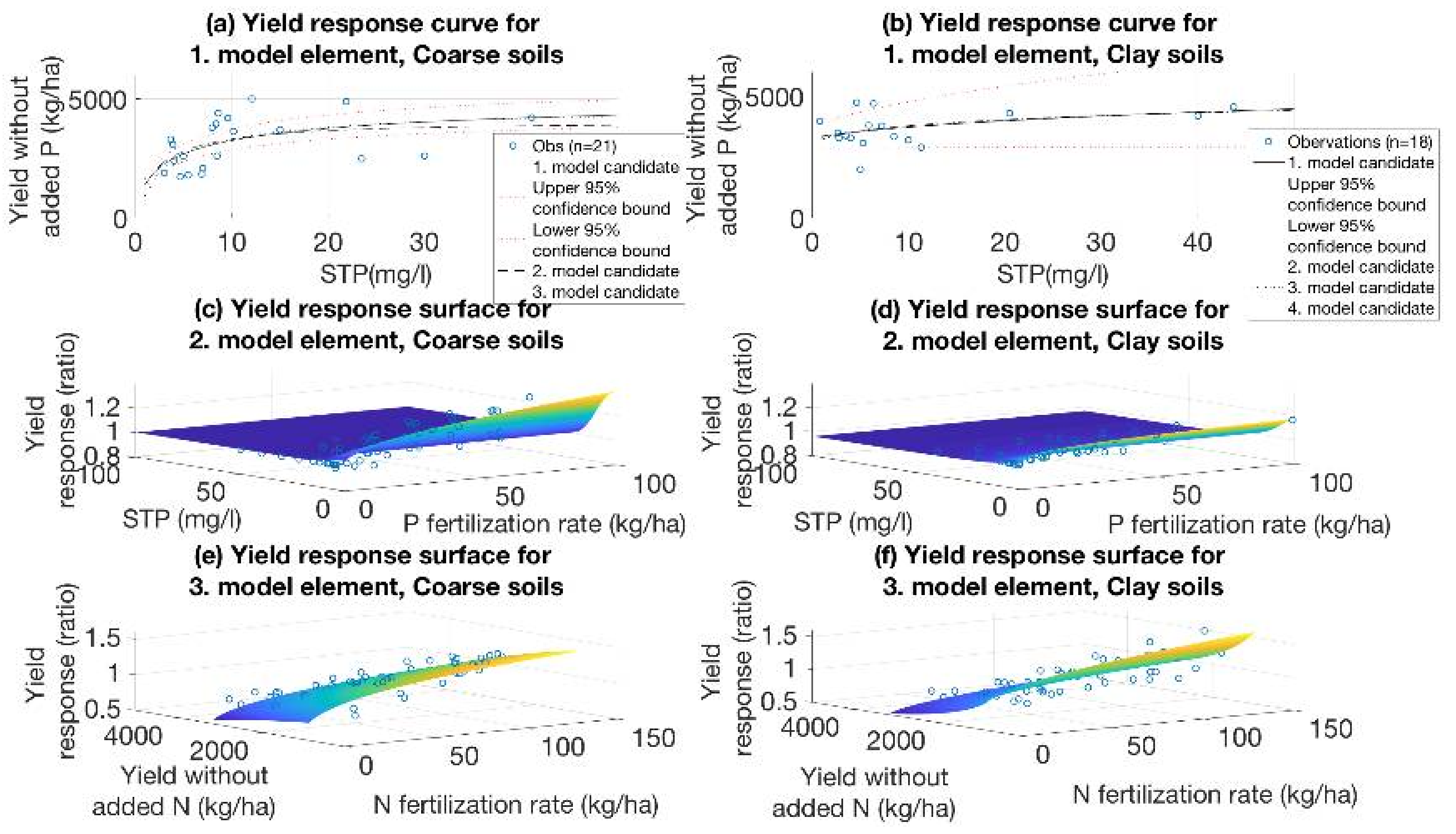
Appendix A.5. Sensitivity Analysis Results
| Parameter | Value | Steady-State P Rate | Steady-State N Rate | Steady-State Yield | |||
|---|---|---|---|---|---|---|---|
| Coarse Soils | Clays Soils | Coarse Soils | Clay Soils | Coarse Soils | Clay Soils | ||
| P price (€/kg) | 1 | 27.9 | 13 | 101.8 | 108.6 | 4123 | 3644 |
| 1.99 (baseline) | 21.7 | 6.78 | 95.8 | 102.4 | 3959 | 3509 | |
| 3 | 15.7 | 4.06 | 87.5 | 98.4 | 3699 | 3416 | |
| N price (€/kg) | 0.5 | 25 | 10.5 | 207 | 344.6 | 4635 | 4868 |
| 0.91 (baseline) | 21.7 | 6.78 | 95.8 | 102.5 | 3959 | 3509 | |
| 2 | 17.6 | 4.57 | 32.1 | 20.9 | 3183 | 2626 | |
| Barley price (€/kg) | 0.06 | 5.79 | 1.78 | 28.5 | 23.8 | 2693 | 2600 |
| 0.12 (baseline) | 21.75 | 6.78 | 95.8 | 102.4 | 3959 | 3509 | |
| 0.24 | 31.17 | 19.25 | 244.8 | 443.2 | 4898 | 5387 | |
| Discount rate (%) | 1 | 24.37 | 8.1 | 97.1 | 102.3 | 4029 | 3526 |
| 3.5 (baseline) | 21.75 | 6.78 | 95.8 | 102.4 | 3959 | 3509 | |
| 6 | 19.85 | 6.41 | 94.9 | 102.6 | 3897 | 3504 | |
References
- Snyder, C.S.; Bruulsem, W.T. Nutrient Use Efficiency and Effectiveness in North America: Indices of Agronomic and Environmental Benefit; International Plant Nutrition Institute: Peachtree Corners, GA, USA, 2007. [Google Scholar]
- Reetz, H.F., Jr. Fertilizers and their Efficient Use; International Fertilizer Industry Association (IFA): Paris, France, 2016; p. 114. [Google Scholar]
- Kang, Y.; Khan, S.; Ma, X. Climate change impacts on crop yield, crop water productivity and food security—A review. Prog. Nat. Sci. 2009, 19, 1665–1674. [Google Scholar] [CrossRef]
- Asseng, S.; Ewert, F.; Rosenzweig, C.; Jones, J.W.; Hatfield, J.L.; Ruane, A.C. Uncertainty in simulating wheat yields under climate change. Nat. Clim. Chang. 2013, 3, 827–832. [Google Scholar] [CrossRef]
- Popp, A.; Calvin, K.; Fujimori, S.; Havlik, P.; Humpenöder, F.; Stehfest, E.; Bodirskyah, B.L.; Dietricha, J.; Doelmanne, J.C.; Gusti, M.; et al. Land-use futures in the shared socio-economic pathways. Glob. Environ. Chang. 2017, 42, 331–345. [Google Scholar] [CrossRef]
- Gilbert, N. The disappearing nutrient. Nature 2009, 461, 716–718. [Google Scholar] [CrossRef] [PubMed]
- Bock, B.R.; Sikora, F.J. Modified-Quadratic/Plateau Model for Describing Plant Responses to Fertilizer. Soil Sci. Soc. Am. J. 1990, 54, 1784–1789. [Google Scholar] [CrossRef]
- Cerrato, M.E.; Blackmer, A.M. Comparison of models for describing corn yield response to nitrogen fertilizer. Agron. J. 1990, 82, 138–143. [Google Scholar] [CrossRef]
- Valkama, E.; Salo, T.; Esala, M. Nitrogen balances and yields of spring cereals as affected by nitrogen fertilization in northern conditions: A meta-analysis. Agric. Ecosyst. Environ. 2013, 164, 1–13. [Google Scholar] [CrossRef]
- Judel, G.K.; Gebauer, W.G.; Mengel, K. Yield response and availability of various phosphate fertilizer types as estimated by EUF. Plant Soil 1985, 83, 107–115. [Google Scholar] [CrossRef]
- Saarela, I.; Järvi, A.; Hakkola, H.; Rinne, K. Fosforilannoituksen Porraskokeet 1977–1994; Vuosittain Annetun Fosforimäärän Vaikutus Maan Viljavuuteen ja Peltokasvien Satoon Monivuotisissa Kenttäkokeissa. Maatalouden Tutkimuskeskus Tiedote 16/95; Maatalouden Tutkimuskeskus: Jokioinen, Finland, 1995. [Google Scholar]
- Valkama, E.; Uusitalo, R.; Turtola, E. Yield response models to phosphorus application: A research synthesis of Finnish field trials to optimize fertilizer P use of cereals. Nutr. Cycl. Agroecosyst. 2011, 91, 1–15. [Google Scholar] [CrossRef] [Green Version]
- Yajragupta, Y.; Halley, L.E.; Melsted, S.W. Correlation of phosphorus soil test values with rice yields in Thailand. Soil Sei Soe. Am. Proe. 1963, 27, 395–398. [Google Scholar] [CrossRef]
- Analogides, D.; Rendig, V.V. Functional Relationships between Yield Response and Soil Phosphorus Supply, Choice of the independent variable. Plant Soil 1972, 37, 545–559. [Google Scholar] [CrossRef]
- Dodd, J.R.; Mallarino, A.P. Soil-test Phosphorus and Crop Grain Yield Responses to Long-Term Phosphorus Fertilization for Crop-Soybean Rotations. Soil Sci. Soc. Am. J. 2005, 69, 1118–1128. [Google Scholar] [CrossRef]
- Kennedy, J.O.S.; Whan, I.F.; Jackson, R.; Dillon, J.L. Optimal fertilizer carry-over and crop recycling policies for a tropical grain crop. Aust. J. Agric. Econ. 1973, 147, 104–113. [Google Scholar]
- Iho, A.; Laukkanen, M. Precision phosphorus management and agricultural phosphorus loading. Ecol. Econ. 2012, 77, 91–102. [Google Scholar] [CrossRef]
- Lambert, D.M.; Lowenberg-DeBoer, J.; Malzer, G. Managing phosphorus soil dynamics over space and time. Agric. Econ. 2007, 37, 43–53. [Google Scholar] [CrossRef]
- Hansen, S.; Jensen, H.E.; Nielsen, N.E.; Svendsen, H. DAISY: A Soil Plant System Model; Danish Simulation Model for Transformation and Transport of Energy and Matter in the Soil-Plant-Atmosphere System; National Agency for Environmental Protection: Copenhagen, Denmark, 1990.
- Eckersten, H.; Jansson, P.-E.; Johnsson, H. SOILN Model–User’s Manual, 2nd ed.; Division of Agricultural Hydrotechnics Communications, Department of Soil Sciences, Swedish University of Agricultural Sciences: Uppsala, Sweden, 1994; p. 58. [Google Scholar]
- Keating, B.A.; Carberry, P.S.; Hammer, G.L.; Probert, M.E.; Robertson, M.J.; Holzworth, D. An overview of APSIM, a model designed for farming systems simulation. Eur. J. Agron. 2003, 18, 267–288. [Google Scholar] [CrossRef]
- Strauss, F.; Schmid, E.; Moltchanova, E.; Formayer, H.; Wang, X. Modeling climate change and biophysical impacts of crop production in the Austrian Marchfeld Region. Clim. Chang. 2012, 111, 641–664. [Google Scholar] [CrossRef]
- Van der Velde, M.; Folberth, C.; Balkovič, J.; Ciais, P.; Fritz, S.; Janssens, I.A. African crop yield reductions due to increasingly unbalanced Nitrogen and Phosphorus consumption. Glob. Chang. Biol. 2014, 20, 1278–1288. [Google Scholar] [CrossRef] [PubMed]
- Dzotsi, K.A.; Jones, J.W.; Adiku, S.G.K.; Naab, J.B.; Singh, U.; Porter, C.H.; Gijsman, A.J. Modeling soil and plant phosphorus within DSSAT. Ecol. Model. 2010, 211, 2839–2849. [Google Scholar] [CrossRef]
- Cichota, R.; Snow, V.O. Estimating nutrient loss to waterways—An overview of models of relevance to New Zealand pastoral farms. N. Z. J. Agric. Res. 2009, 52, 239–260. [Google Scholar] [CrossRef]
- Bolland, M.D.A.; Allen, D.G.; Barroe, N.J. Sorption of Phosphorus by Soils: How It Is Measured in Western Australia; Bulletin 4591; Department of Agriculture and Food: Kensington, Australia, 2003; p. 32.
- Li, X.; Coble, K.H.; Tack, J.B.; Barnett, B.J. Estimating Site-Specific Crop Yield Response using Varying Coefficient Models. Selected. In Proceedings of the 2016 Agricultural & Applied Economics Association Annual Meeting, Boston, MA, USA, 31 July–2 August 2016; p. 30. [Google Scholar]
- Sargent, R.G. Verification and validation of simulation models. In Proceedings of the 2011 Winter Simulation Conference, Phoenix, AZ, USA, 11–14 December 2011; Jain, S., Creasey, R.R., Himmelspach, J., White, K.P., Fu, M., Eds.; IEEE: Piscataway, NJ, USA, 2011; pp. 183–198. [Google Scholar]
- Saarela, I.; Järvi, A.; Hakkola, H.; Rinne, K. Phosphorus status of diverse soils in Finland as influenced by long-term P fertilization 2. Changes of soil test values in relation to P balance with references to incorporation depth of residual and freshly applied P. Agric. food Silenc. 2004, 13, 276–294. [Google Scholar] [CrossRef]
- Salo, T.; Turtola, E.; Virkajärvi, P.; Saarijärvi, K.; Kuisma, P.; Tuomisto, J.; Susanna, M.; Marja, T. Nitrogen Fertilizer Rates, N Balances, and Related Risk of N Leaching in Finnish Agriculture. MTT Report 102. 2013. Available online: http://www.mtt.fi/mttraportti/pdf/mttraportti102.pdf (accessed on 4 June 2017).
- Valkama, E.; Uusitalo, R.; Ylivainio, K.; Virkajärvi, P.; Turtola, E. Phosphorus fertilization: A meta-analysis of 80 years of research in Finland. Agric. Ecosyst. Environ. 2009, 130, 75–85. [Google Scholar] [CrossRef]
- Sheahan, M.; Black, R.; Jayne, T.S. Are Kenyan Farmers Under-Utilizing Fertilizer? Implications for Input Intensification Strategies and Reseach. Food Policy 2013, 41, 39–52. [Google Scholar] [CrossRef]
- Refsgaard, J.C.; Van der Sluijs, J.P.; Hojberg, A.L.; Vanrolleghem, P.A. Uncertainty in the environmental modelling process—A framework and guidance. Environ. Model. Softw. 2007, 22, 1543–1556. [Google Scholar] [CrossRef]
- Bennett, N.D.; Croke, B.F.W.; Guariso, G.; Guillaume, J.H.A.; Hamilton, S.H.; Jakeman, A.J.; Marsili-Libellic, S.; Newhama, L.T.H.; Nortona, J.P.; Perrin, C.; et al. Characterising performance of environmental models. Environ. Model. Softw. 2013, 40, 1–20. [Google Scholar] [CrossRef]
- Archontoulis, S.V.; Miguez, F.E. Nonlinear Regression Models and Applications in Agricultural Research. Agron. J. 2015, 107, 786–798. [Google Scholar] [CrossRef]
- Akaike, H. Information theory as an extension of the maximum likelihood principle. In The Second International Symposium on Information Theory; Petrov, B.N., Csaki, F., Eds.; Akademiai Kiado: Budapest, Hungary, 1973; pp. 267–281. [Google Scholar]
- Atkins, R.E.; Stanford, G.; Dumenil, L. Effects of Nitrogen and Phosphorus Fertilizer on Yield and Malting Quality of Barley. Plant Nutr. Eff. 1955, 3, 609–615. [Google Scholar]
- Cerutti, T.; Delatorre, C.A. Nitrogen and phosphorus interaction and cytokinin: Responses of the primary root of Arabidopsis thaliana and the pdr1 mutant. Plant Sci. 2013, 198, 91–97. [Google Scholar] [CrossRef] [PubMed]
- Kassa, M.; Sorsa, Z. Effect of Nitrogen and Phosphorus Fertilizer Rates on Yield and Yield Components of Barley (Hordeum Vugarae L.) Varieties at Damot Gale District, Wolaita Zone, Ethiopia. Am. J. Agric. For. 2015, 3, 271–275. [Google Scholar] [CrossRef]
- Sharpley, A.N. Disposition of fertilizer phosphorus applied to winter wheat. Soil Sci. Soc. Am. J. 1986, 50, 953–958. [Google Scholar] [CrossRef]
- McLaughlin, M.J.; Alston, A.M.; Martin, J.K. Phosphorus cyclin in wheat-pasture rotations. I. The source of phosphorus taken up by wheat. Aust. J. Soil Res. 1988, 26, 323–331. [Google Scholar] [CrossRef]
- Hooda, P.; Truesdale, V.; Edwards, A.; Withers, P.; Aitken, M.; Miller, A.; Rendell, A. Manuring and Fertilization Effects on Phosphorus Accumulation in Soils and Potential Environmental Implications. Adv. Environ. Res. 2001, 5, 13–21. [Google Scholar] [CrossRef]
- Barrow, N.J. Evaluation and utilization of residual phosphorus in soils. In Proceedings of the a Symposium The Role of Phosphorus in Agriculture, National Fertilizer Development Center, Tennessee Valley Authority, Muscle Shoals, AL, USA, 1–3 June 1976; Khasawneh, F.E., Sample, E.C., Kamprath, E.J., Eds.; American Society of Agronomy, Crop Science Society of America, Soil Science Society of America: Madison, WI, USA, 1980; pp. 333–359. [Google Scholar]
- Syers, J.K.; Johnston, A.E.; Curtin, D. Efficiency of Soil and Fertilizer Phosphorus Use. Reconciling Changing Concepts of Soil Phosphorus Behaviour with Agronomic Information; FAO, Fertilizer and Plant Nutrient Bulletin; FAO: Rome, Italy, 2008; Volume 18, pp. 1–108. [Google Scholar]
- Engelstad, O.P.; Teraman, G.L. Agronomic Effectiveness of Phosphate Fertilizers. In Proceedings of the a Symposium The Role of Phosphorus in Agriculture, National Fertilizer Development Center, Tennessee Valley Authority, Muscle Shoals, AL, USA, 1–3 June 1976; Khasawneh, F.E., Sample, E.C., Kamprath, E.J., Eds.; American Society of Agronomy, Crop Science Society of America, Soil Science Society of America: Madison, WI, USA, 1980; pp. 311–332. [Google Scholar]
- Mallarino, A.P.; Prater, J. Corn and soybean grain yield, phosphorus removal, and soil-test responses to long-term phosphorus fertilization strategies. In Proceedings of the 2007 Integrated Crop Management Conference, Ames, IA, USA, 28–29 November 2007; pp. 241–254. [Google Scholar]
- Ylivainio, K.; Sarvi, M.; Lemola, R.; Uusitalo, R.; Turtola, E. Regional P stocks in Soil and in Animal Manure As comparEd to P Requirement of Plants in Finland. Baltic Forum for Innovative Technologies for Sustainable Manure Management. WP4 Standardisation of Manure Types with Focus on Phosphorus. MTT Report 124. 2014, p. 35. Available online: http://jukuri.luke.fi/handle/10024/481761 (accessed on 10 December 2017).
- Vuorinen, J.; Mäkitie, O. The method of soil testing in use in Finland. Agrogeol. Publ. 1955, 63, 1–44. [Google Scholar]
- Hardaker, J.B.; Gudbrand, L.; Anderson, J.R.; Huirne, R.B.M. Coping with Risk in Agriculture, 3rd ed.; Applied Decision Analysis: Wallingford, Oxfordshire, UK, 2015; p. 276. [Google Scholar]
- Esala, M.; Larpes, G. Kevätviljojen Sijoituslannoitus Savimailla; MTTK–Maatalouden Tutkimuskeskus, Tiedote 2/84; Maanviljelyskemian ja–Fysiikan Osasto: Jokioinen, Finland, 1984; ISSN 0359-7652. [Google Scholar]
- Cobb, C.W.; Douglas, P.H. A Theory of Production. Am. Econ. Rev. 1928, 18, 139–165. [Google Scholar]
- Frank, M.D.; Beattie, B.R.; Embleton, M.E. A Comparison of Alternative Crop Response Models. Am. J. Agric. Econ. 1990, 72, 597–603. [Google Scholar] [CrossRef]
- Chambers, R.G. Applied Production Analysis—A Dual Approach; Cambridge University Press: Cambridge, UK, 1988; p. 331. [Google Scholar]
- Carlgren, K.; Mattson, L. Swedish Soil Fertility Experiments. Acta Agric. Scand. Sect. B Soil Plant Sci. 2001, 51, 49–76. [Google Scholar] [CrossRef]
- Andrews, D.W.K. Heteroskedasticity and Autocorrelation Consistent Covariance Matrix Estimation. Econometrica 1991, 59, 817–858. [Google Scholar] [CrossRef]
- Hojberg, A.L.; Refsgaard, J.C. Model uncertainty–parameter uncertainty versus conceptual models. Water Sci. Technol. 2005, 52, 177–186. [Google Scholar] [PubMed]
- Griffin, R.C.; Montgomerym, J.M.; Rister, M.E. Selecting Functional Form in Production Function Analysis. West. J. Agric. Econ. 1987, 12, 216–227. [Google Scholar]
- Burnham, K.P.; Anderson, D.R. Model Selection and Multimodel Inference: A Practical Information-Theoretic Approach, 2nd ed.; Springer: Berlin, Germany, 2002; p. 488. [Google Scholar]
- Nash, J.E.; Sutcliffe, J.V. River flow forecasting through conceptual models part I—A discussion of principles. J. Hydrol. 1970, 10, 282–290. [Google Scholar] [CrossRef]
- Moriasi, D.N.; Arnold, J.G.; van Liew, M.W.; Bingner, R.I.; Harmel, R.D.; Veith, T.I. Model Evaluation Guidelines for Systematic Quantification of Accuracy in Watershed Simulations. Soil Water Div. ASABE 2007, 50, 885–900. [Google Scholar]
- Willmot, C.J. On the validation of models. Phys. Geogr. 1981, 2, 184–194. [Google Scholar]
- Kleijnen, J.P.C. Theory and Methodology–Verification and validation of simulation models. Eur. J. Oper. Res. 1995, 82, 145–162. [Google Scholar] [CrossRef]
- Marcus, A.H.; Elias, R.W. Some Useful Statistical Methods for Model Validation. Environ. Health Perpect. 1998, 106, 1541–1550. [Google Scholar] [CrossRef]
- Uusitalo, R.; Hyväluoma, J.; Valkama, E.; Ketoja, E.; Vaahtoranta, A.; Virkajärvi, P. A Simple Dynamic Model of Soil Test Phosphorus Responses to Phosphorus Balances. J. Environ. Qual. 2016, 45, 977–983. [Google Scholar] [CrossRef] [PubMed]
- Bellman, R. Dynamic Programming; Princeton University Press: Princeton, NJ, USA, 1957; p. 339. [Google Scholar]
- Ikefuji, M.; Laeven, R.J.A.; Magnus, J.R.; Muris, C.H.M. Scrap Value Functions in Dynamic Decision Problems; CentER Discussion Paper 77; Tilburg University: Tilburg, The Netherlands, 2010; p. 18. [Google Scholar] [CrossRef]
- Debertin, D.L. Agricultural Production Economics, 2nd ed.; Amazon Createspace: North Charleston, SC, USA, 2012; p. 431. [Google Scholar]
- Berthold, M.; Hand, D. Intelligent Data Analysis. An Introduction, 2nd ed.; Springer: Berlin/Heidelberg, Germany; New York, NY, USA, 2007; ISBN 3-540-43060-1. [Google Scholar]
- Ministry of Agriculture and Forestry. Government Regulation of Environmental Compensation; Ministry of Agriculture and Forestry: Helsinki, Finland, 2014. Available online: https://www.edilex.fi/saadoskokoelma/20150235.pdf. Web address verified 04 01.2018 (accessed on 17 April 2016). (In Finnish)
- Jones, W.J.; Antle, J.M.; Basso, B.; Boote, K.J.; Conant, R.T.; Foster, I.; Godfray, H.C.J.; Herrero, M.; Howitt, R.E.; Janssen, S.; et al. Brief history of agricultural systems modeling. Agric. Syst. 2017, 155, 240–254. [Google Scholar] [CrossRef] [PubMed]
- Sumner, M.E.; Farina, M.P.W. Phosphorus Interactions with Other Nutrients and Lime in Field Cropping Systems. Adv. Soil Sci. 1986, 5, 201–236. [Google Scholar] [CrossRef]
- Cox, F.R. Range in soil phosphorus critical levels with time. Soil Sci. Soc. Am. J. 1992, 56, 1504–1509. [Google Scholar] [CrossRef]
- Cope, J.T. Effects of 50 Years of Fertilization with Phosphorus and Potassium on Soil Test Levels and Yields at Six Locations. Soil Sci. Soc. Am. J. 1981, 45, 342–347. [Google Scholar] [CrossRef]
- Taylor, A.W.; Pionke, H.B. Inputs of Phosphorus toe the Chesapeake Bay Watershed. In Agriculture and Phosphorus Management: The Chesapeake Bay; Sharpley, A.N., Ed.; CRC Press: Boca Raton, FL, USA, 1999; p. 256. [Google Scholar]
- Dobus, I.; Brown, C.; Beulke, S. Sources of uncertainty in pesticide fate modelling. Sci. Total Environ. 2003, 317, 53–72. [Google Scholar] [CrossRef]
- Abraham, T.P.; Rao, V.Y. An investigation on functional models for fertilizer response studies. J. Indian Soc. Agric. Stat. 1965, 18, 45–61. [Google Scholar]
- Brorsen, B.D.; Richter, F.G.-C. Experimental designs for estimating plateau-type production functions and economically optimal input levels. J. Prod. Anal. 2012, 38, 45–52. [Google Scholar] [CrossRef]
- Addiscott, T.M.; Tuck, G. Non-linearity and error in modelling soil processes. Eur. J. Soil Sci. 2001, 52, 129–138. [Google Scholar] [CrossRef]
- Schoups, G.; Hopmans, J.W. Evaluation of model complexity and input uncertainty of field-scale water flow and salt transport. Vadose Zone J. 2006, 5, 951–962. [Google Scholar] [CrossRef]
- Briggs, A.H.; Weinstein, M.C.; Fenwick, E.A.L.; Karnon, J.; Sculpher, M.J.; Paltiel, A.D. Model Parameter Estimation and Uncertainty: A Report of the ISPOR-SMDM Modeling Good Research Practices Task Force-6. Value Health 2012, 15, 835–842. [Google Scholar] [CrossRef] [PubMed]
- Pereira, A.R. Simulação do crescimento e da produtividade. In Simpósio Sobre o Manejo de Água Na Agricultura Anais; Fundação Cargill: Campinas, Brazil, 1987; p. 226. [Google Scholar]
- Dodd, J.R.; McDowell, R.W.; Condron, L.M. Predicting the changes in environmentally and agronomically significant phosphorus forms following cessation of phosphorus fertilizer applications to grassland. Soil Use Manag. 2012, 28, 135–147. [Google Scholar] [CrossRef]
- Ylivainio, K.; Jauhiainen, L.; Uusitalo, R.; Turtola, E. Waterlogging severely retards P use efficiency of spring barley (Hordeum vulgare). J. Agro Crop Sci. 2018, 204, 74–85. [Google Scholar] [CrossRef]
- Karlsson, T. Carbon and Nitrogen Dynamics in Agricultural Soils Model Applications at Different Scales in Time and Space. Ph.D. Thesis, Swedish University of Agricultural Sciences, Uppsala, Sweden, 2012. [Google Scholar]
- Baoqing, C.; Enke, L.; Qizhuo, T.; Changrong, Y.; Yanqing, Z. Soil nitrogen dynamics and crop residues. A review. Agron. Sustain. Dev. 2014, 34, 429–442. [Google Scholar] [CrossRef]
- Wild, B.; Schnecker, J.; Knoltsch, A.; Takriti, M.; Mooshammer, M.; Gentsch, N. Microbial nitrogen dynamics in organic and mineral soil horizons along a latitudinal transect in western Siberia. Glob. Biogeochem. Cycles 2015, 29, 567–582. [Google Scholar] [CrossRef] [PubMed] [Green Version]
- Tumusiime, E.; Brorsen, B.W.; Mosali, J.; Johnson, J.; Locke, J.; Biermacher, J.T. Determining Optimal Levels of Nitrogen Fertilizer Using Random Parameter Models. J. Agric. Appl. Econ. 2011, 43, 541–552. [Google Scholar] [CrossRef]
- Boyer, C.N.; Larson, J.A.; Roberts, R.K.; McClure, A.T.; Tyler, D.D.; Zhou, V. Stochastic Corn Yield Response Functions to Nitrogen for Corn after Corn, Corn after Cotton, and Corn after Soybeans. J. Agric. Appl. Econ. 2013, 45, 669–681. [Google Scholar] [CrossRef]
- Ray, D.K.; Gerber, J.S.; MacDonald, G.K.; West, P.C. Climate variation explains a third of global crop yield variability. Nat. Commun. 2015, 6, 9. [Google Scholar] [CrossRef] [PubMed]
- Nemeth, T. Application of the Bray-Mitscherlich equation approach for economically and environmentally sound fertilization of field crops in Hungary. Commun. Soil Sci. Plant Anal. 2006, 37, 2227–2247. [Google Scholar] [CrossRef]
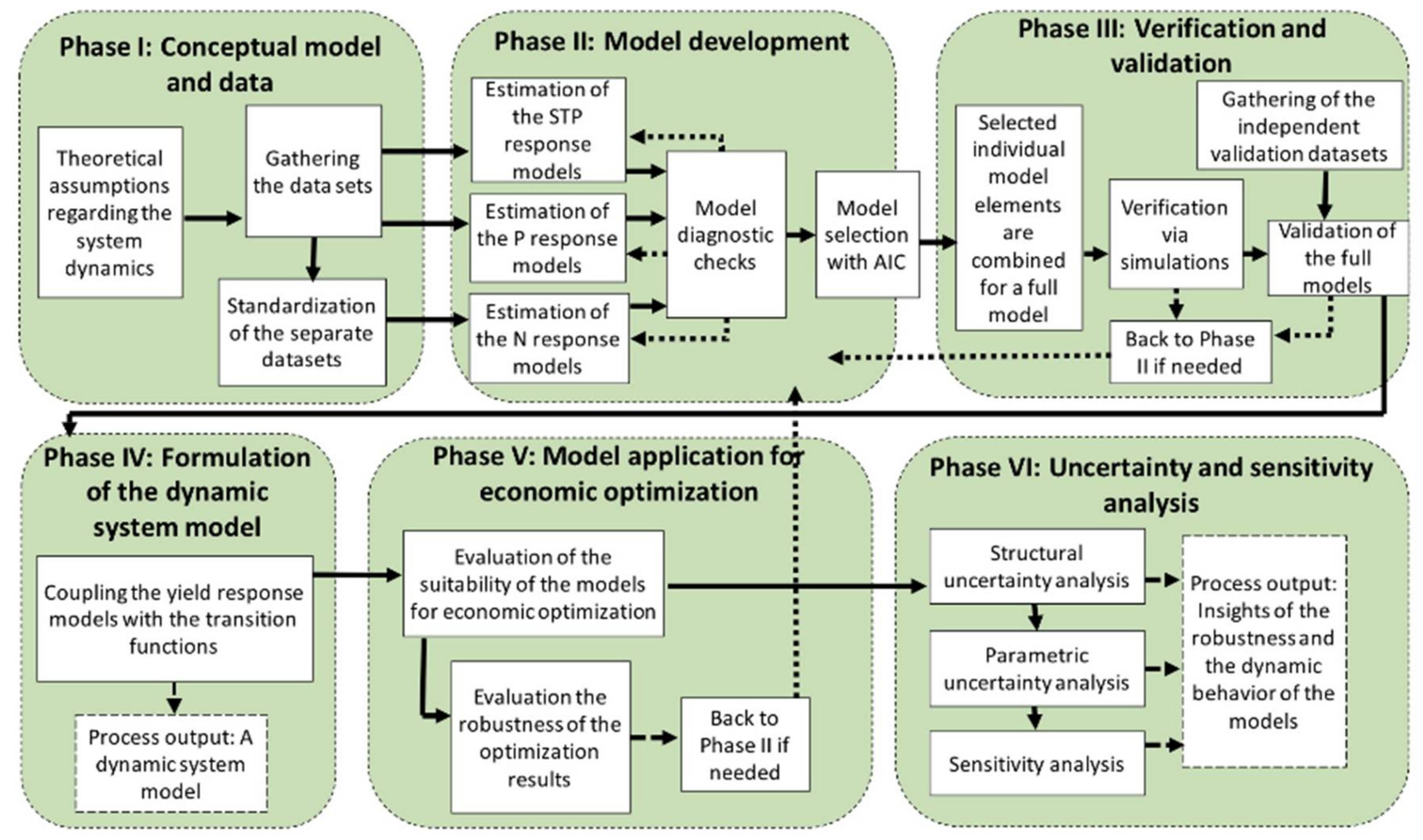

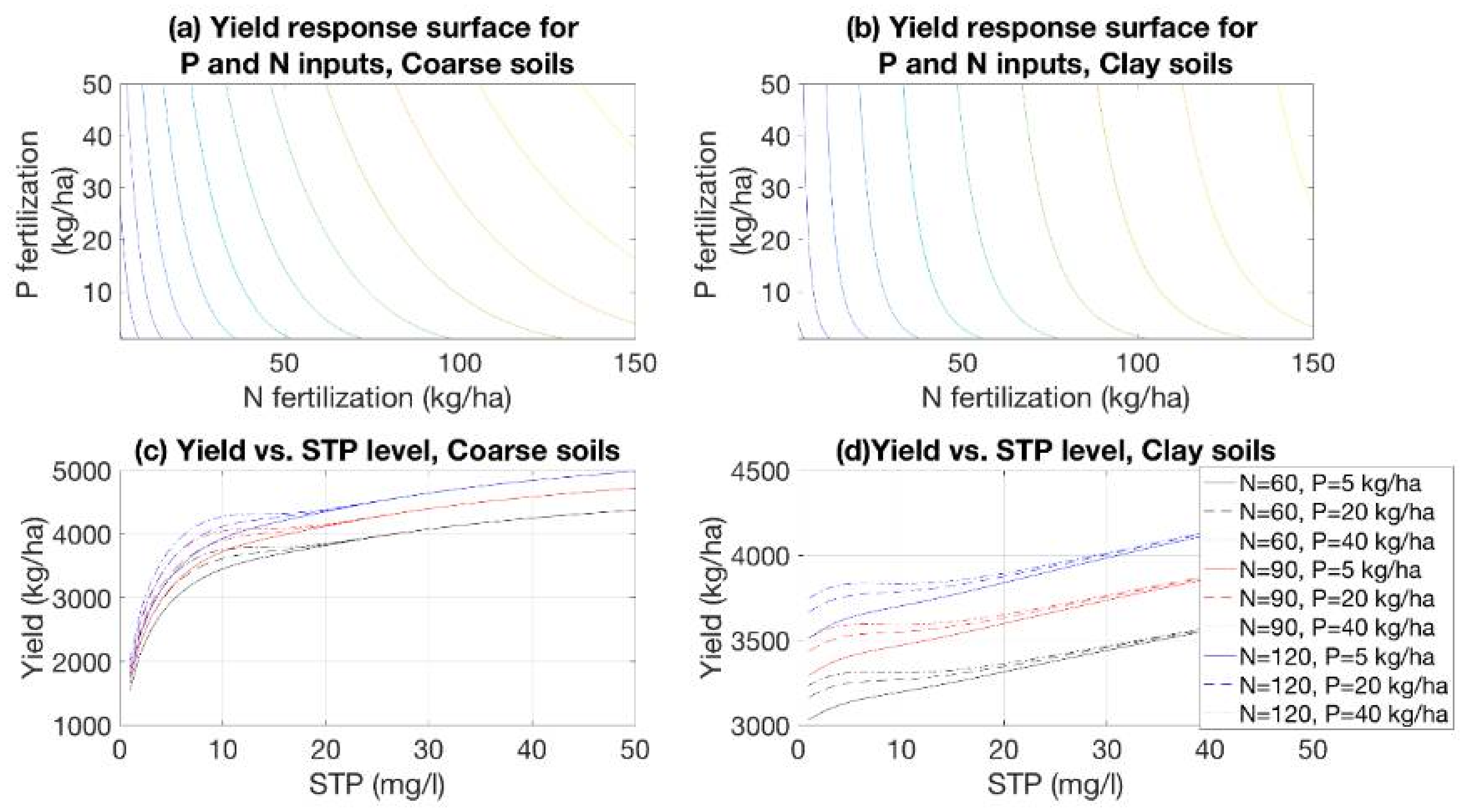

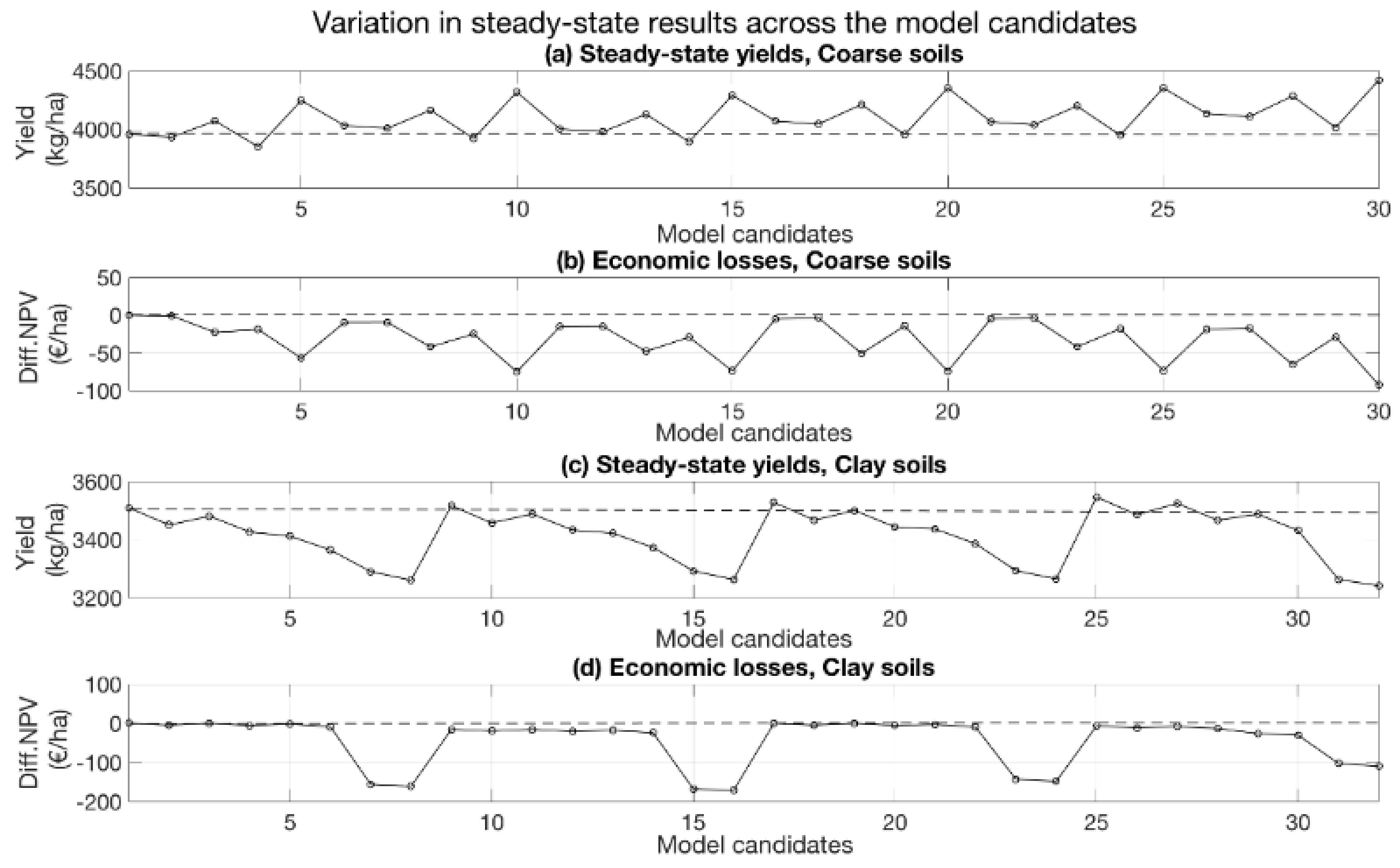

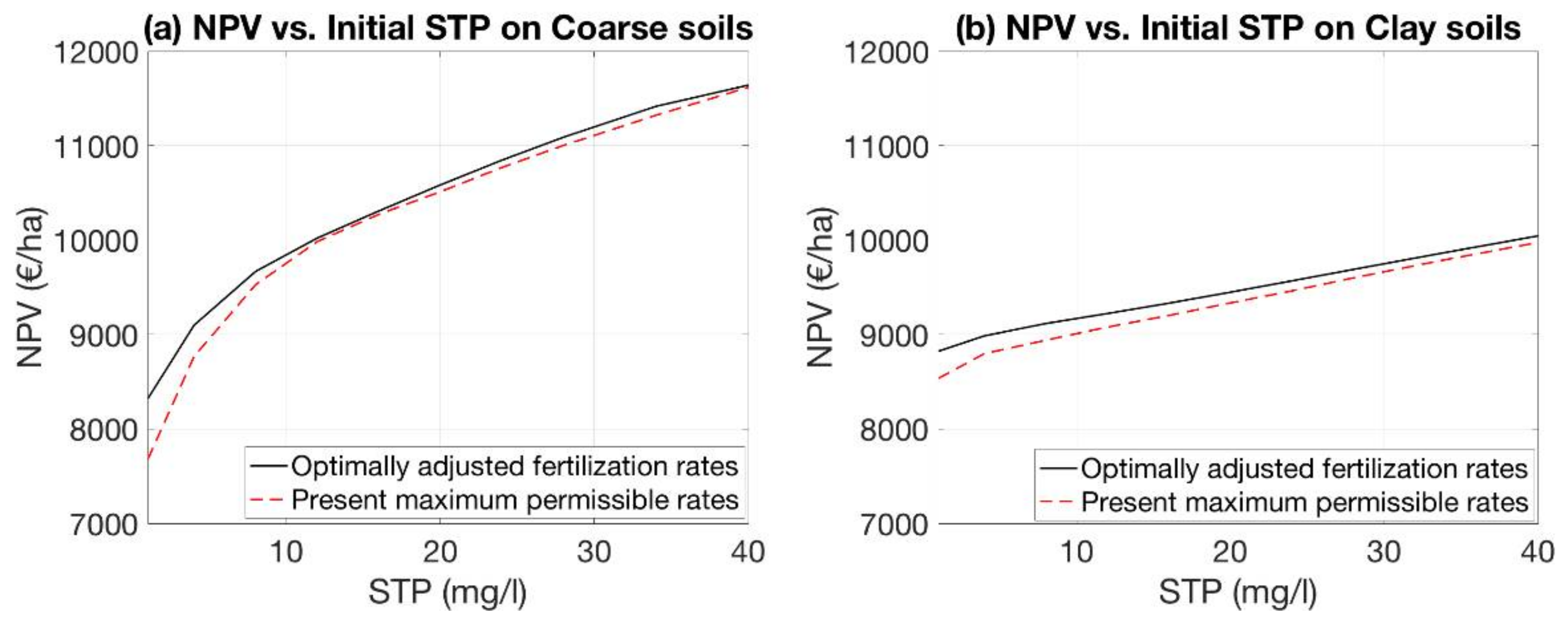
| Soil Texture | Parameter | Estimate | SD * | t-Value | P (>) |
|---|---|---|---|---|---|
| Coarse | 0.0133 | 4.535 × 10−4 | 29.37 | <2.2 × 10−16 | |
| 0.0797 | 0.0126 | 6.33 | 2.747 × 10−8 | ||
| 0.0095 | 0.0031 | 3.09 | 0.0029 | ||
| 0.727 | 0.0742 | 9.787 | 4.791 × 10−14 | ||
| 0.0269 | 0.00269 | 10.01 | 2.023 × 10−14 | ||
| 3.653 × 10−8 | 6.694 × 10−9 | 5.46 | 9.699 × 10−7 | ||
| Clay | 0.317 | 0.150 | 2.12 | 0.0493 | |
| 65.80 | 1.248 | 52.74 | <2.2 × 10−16 | ||
| 0.0372 | 0.0041 | 9.08 | 2.93 × 10−11 | ||
| 0.010 | 0.0045 | 2.232 | 0.0313 | ||
| 0.0799 | 0.021 | 3.81 | 6 × 10−4 | ||
| 0.0377 | 0.0048 | 7.91 | <2.2 × 10−16 |
| Soil Texture | Number of the Model Element ‡ | NSE | RMSE | MB | MAE | |
|---|---|---|---|---|---|---|
| Coarse | (1) | 0.62 | 0.36 | 939 (29%) | −65 (2.0%) | 811 (25.2%) |
| (2) | 0.8 | 0.63 | 0.07 (6.5%) | 0.01 (0.9%) | 0.05 (4.6%) | |
| (3) | 0.87 | 0.76 | 0.09 (9.2%) | 0.01 (1.0%) | 0.07 (7.2%) | |
| Clay | (1) | 0.46 | 0.21 | 630 (2.3%) | 32.28 (0.8%) | 458.1 (12%) |
| (2) | 0.76 | 0.54 | 0.04 (3.8%) | 0.005 (4.7%) | 0.03 (2.9%) | |
| (3) | 0.94 | 0.89 | 0.08 (8.5%) | 0.01 (0.6%) | 0.06 (6.4%) |
| Soil Texture | r | NSE | RMSE | MAE | MB |
|---|---|---|---|---|---|
| Coarse | 0.81 | 0.66 | 452 (12%) | 338 (9.2%) | 21.1 (0.6%) |
| Clay | 0.76 | 0.54 | 706 (21%) | 564 (17%) | 132 (4%) |
| Soil Texture | Test | Test Statistic | p-Value |
|---|---|---|---|
| Coarse | Shapiro−Wilk normality test | 0.95 | 0.124 |
| t-test for coefficient in Equation (5) | −35.9 | 0.96 | |
| t-test for coefficient in Equation (5) | 1.004 | 3.66 × 10−6 | |
| Paired t-test | −0.124 | 0.902 | |
| Clay | Shapiro−Wilk normality test | 0.98 | 0.55 |
| t-test for coefficient in Equation (5) | −713 | 0.119 | |
| t-test for coefficient in Equation (5) | 1.17 | 7.155 × 10−13 | |
| Paired t-test | −0.87 | 0.39 |
| Soil Texture | Variable ‡ | Values Characterizing the Steady State | |
|---|---|---|---|
| Values Obtained by Dynamic Optimization | Values Obtained by Simulating the Model Using the Present Maximum Permissible Fertilization Rates § | ||
| Coarse | N rate (kg N ha−1 a−1) | 95.8 | 100 |
| P rate (kg P ha−1 a−1) | 21.7 | 16 | |
| STP (mg P l−1 a−1) | 9.88 | 7.85 | |
| Yield (kg ha−1 a−1) | 3958 | 3795 | |
| Profit (€ ha−1 a−1) | 345 | 333 | |
| NPV (€ ha−1) | 9614 | 9446 | |
| Clay | N rate (kg N ha−1 a−1) | 102.4 | 100 |
| P rate (kg P ha−1 a−1) | 6.75 | 16 | |
| STP (mg P l−1 a−1) | 3.86 | 6.81 | |
| Yield (kg ha−1 a−1) | 3509 | 3603 | |
| Profit (€ ha−1 a−1) | 314.3 | 309.6 | |
| NPV (€ ha−1) | 9006 | 8809 | |
| Soil Texture | Variable ‡ | Average Steady-State Value (95% CI) | Range (min, max) | SD/Average |
|---|---|---|---|---|
| Coarse | N rate (kg N ha−1 a−1) | 103 (73.7, 132) | (82.8, 125) | 0.139 |
| P rate (kg P ha−1 a−1) | 22.8 (19.6, 26) | (19.6, 25.7) | 0.07 | |
| STP (mg P l−1 a−1) | 10.1 (8.96, 11.2) | (9.08, 10.9) | 0.055 | |
| Yield (kg ha−1 a−1) | 4100 (3790, 4410) | (3852, 4421) | 0.037 | |
| Profit (€ ha−1 a−1) | 353 (342, 364) | (343, 366) | 0.016 | |
| NPV (€ ha−1) | 9846 (9503, 10190) | (9568, 10200) | 0.017 | |
| NPV (€ ha−1) | −31.8 (−86.9, 23.3) | (−92.3, 0) | −0.85 | |
| Clay | N rate (kg N ha−1 a−1) | 95.2 (84.9, 105) | (86.2, 103) | 0.053 |
| P rate (kg P ha−1 a−1) | 5.96 (1.01, 10.9) | (1.71, 9.36) | 0.41 | |
| STP (mg P l−1 a−1) | 3.79 (2.64, 4.93) | (2.81, 4.64) | 0.15 | |
| Yield (kg ha−1 a−1) | 3412 (3221, 3602) | (3241, 3546) | 0.027 | |
| Profit (€ ha−1 a−1) | 311 (303, 319) | (304, 317) | 0.013 | |
| NPV (€ha−1) | 8914 (8709, 9119) | (8730, 9068) | 0.011 | |
| NPV (€ ha−1) | −44.25 (−168, 79.54) | (−171.3, 0) | −1.37 |
| Soil Texture | Model Element Subject to Parametric Uncertainty | Average Yield (95% CI) | SD (95% CI) | 95% CI (for Mean Values) | SD/Average |
|---|---|---|---|---|---|
| kg ha−1 a−1 | |||||
| Coarse | First model element | 3947 (+/−5) | 270 (+4, −3) | (3397, 4497) | 0.068 |
| Second model element | 3938 (+/−2) | 101 (+2, −1) | (3732, 4144) | 0.026 | |
| Third model element | 3936 (+/−6) | 303 (+/−4) | (3319, 4553) | 0.077 | |
| Entire model | 3955 (+7, −9) | 421 (+/−6) | (3099, 4811) | 0.106 | |
| Clay | First model element | 3518 (+5, −6) | 281 (+/−4) | (2967, 4069) | 0.08 |
| Second model element | 3509 (+/−1) | 41(+/−0.6) | (3429, 3589) | 0.012 | |
| Third model element | 3567 (+/−12) | 636 (+/−11) | (2320, 4814) | 0.178 | |
| Entire model | 3578 (+/−14) | 702 (+/−12) | (2201, 4954) | 0.196 | |
© 2018 by the authors. Licensee MDPI, Basel, Switzerland. This article is an open access article distributed under the terms and conditions of the Creative Commons Attribution (CC BY) license (http://creativecommons.org/licenses/by/4.0/).
Share and Cite
Sihvonen, M.; Hyytiäinen, K.; Valkama, E.; Turtola, E. Phosphorus and Nitrogen Yield Response Models for Dynamic Bio-Economic Optimization: An Empirical Approach. Agronomy 2018, 8, 41. https://doi.org/10.3390/agronomy8040041
Sihvonen M, Hyytiäinen K, Valkama E, Turtola E. Phosphorus and Nitrogen Yield Response Models for Dynamic Bio-Economic Optimization: An Empirical Approach. Agronomy. 2018; 8(4):41. https://doi.org/10.3390/agronomy8040041
Chicago/Turabian StyleSihvonen, Matti, Kari Hyytiäinen, Elena Valkama, and Eila Turtola. 2018. "Phosphorus and Nitrogen Yield Response Models for Dynamic Bio-Economic Optimization: An Empirical Approach" Agronomy 8, no. 4: 41. https://doi.org/10.3390/agronomy8040041






